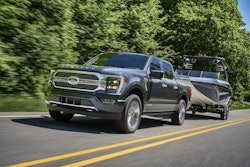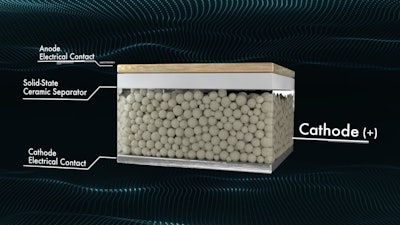
Politics anyone?
Politics has always been a sordid business and especially now following a summer of protests and deadly riots, a contested U.S. presidential election, a deadly breach at the U.S. Capitol and now another impeachment process rolling out for President Donald Trump.
So what does it all mean for trucking? At this point, it’s too early to tell. More panic buying may ensue as people grow leery and concerned about increasing tensions and the instability that can bring.
“Honey?”
“Yes dear?”
“I think we need more toilet paper.”
“Sounds good. Get some more water and canned tuna while you’re at it.”
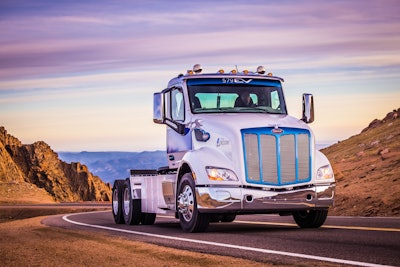 Peterbilt announced this week that its 579EV made several trips up and down Pikes Peak in Colorado. Electric trucks, just like electric cars, continue to improve and are increasingly going to work.
Peterbilt announced this week that its 579EV made several trips up and down Pikes Peak in Colorado. Electric trucks, just like electric cars, continue to improve and are increasingly going to work.So trucks go to work and keep moving the products that people want and need. Does the current state of hyper-divisive politics impede any of that? Thus far the most pressing worries center around the streets and highways filling up with protestors as we saw this past summer. However, winter’s frigid temperatures and the increasing presence of law enforcement may help to keep protestors on the sidelines.
In the meantime, most Americans will arguably carry on at work mindful of keeping divisive topics off the table. But what if the boss weighs in? More importantly, if the boss throws out a few social media posts regarding a political firestorm will it be good for business?
That’s where it gets interesting. People often vote quietly with their feet. They don’t always voice opposition on social media or around the water cooler. So if they find a company that reflects their own values, they’ll often jump on board.
And if that company takes some heat and even endures some hardships for their values, it may even attract more supporters.
Whatever the road taken, in the world of commercial trucks and vans, as with other for-profit industries, there’s no ignoring the bottom line. Political maelstroms come and go and after the dust settles, the victor emerges with playbook at hand.
In this case, President-elect Joe Biden has made it clear repeatedly on the campaign trail and in his published environmental protection plan that he’ll be gunning hard for all-electric zero emissions. Ambitious goals include changing out the entire U.S. fleet with all-electric vehicles and installing additional chargers across the country. Sorry, but there’s no mention of fuel cells in his written plan (or at least there wasn’t on election day) or other alt fuel technologies. But that doesn’t mean that they’re getting shelved. Uncle Sam, various OEMs, fuel suppliers, carriers and their customers have long supported—and still do—various alt fuel technologies.
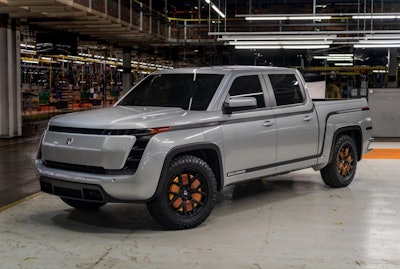 Lordstown announced this week that it has over 100,000 pre-orders for its all-electric commercial pickup. Priced at $52,500, it will be interesting to see how this truck fares as more OEMs prepare to launch their own all-electric pickups.
Lordstown announced this week that it has over 100,000 pre-orders for its all-electric commercial pickup. Priced at $52,500, it will be interesting to see how this truck fares as more OEMs prepare to launch their own all-electric pickups.But zero emissions are the target. And while legislation continues to grow across the country calling for pristine, pollution-free tailpipes, it’s the OEMs, carriers and their customers who stand to win in the long-haul. That’s the key. Success will not come overnight especially for larger class vehicles whose duty cycles are very demanding.
But take heart. All-electric and fuel cell electric powertrains are increasingly growing in efficiency. Nowhere is that more clear than with the solid-state battery developments led by Toyota and Volkswagen-backed QuantumScape (illustrated battery shown above). These batteries are appreciably lighter, take up less space, are more or less non-flammable and deliver roughly twice the energy density of conventional lithium-ion. Fifteen-minute charge times and lower production costs add to their appeal.
There’s never been much doubt about the benefits of electric powertrains which first emerged in the 19th century. In studying the 130-year-old notes of the U.S. Postmaster it’s also clear that the old concerns of yesterday still pervade today: namely lackluster range and lengthy charge times relative to internal combustion. Of course, they can start out strong at the beginning of a route, but weigh them down with a big enough load and their range rapidly depletes. Throw in an exceptionally cold or hot day and the range suffers even more. These are not notable concerns with solid-state.
My family and I recently watched Singin’ in the Rain starring Gene Kelly and Debbie Reynolds. I’m somewhat embarrassed to say that it was my first time seeing the film. I’ve since it watched it again.
 Solid-state battery stats are impressive with nearly twice the energy density of conventional lithium-ion.
Solid-state battery stats are impressive with nearly twice the energy density of conventional lithium-ion.What really stands out for me is the eye-opening transition the story captures as movie studios scramble to take on the new and exciting technology of talking motion pictures, or talkies, while leaving the once-popular world of silent film behind. If you’ve seen the movie then you may recall a warning uttered by a talkie fan who accurately notes the failed pushback from the horse and buggy crowd as the new-fangled and noisy automobile began taking to the streets in greater and greater numbers.
We’re seeing that today with EVs largely thanks to improved battery technology which has long been the key to its advancement. Now that very same technology—conventional lithium-ion—is on the verge of being usurped by solid-state. Toyota told me that they expect their first EV to roll out with this new battery by the mid-2020s. You can bet that QuantumScape and Volkswagen are pushing hard to get to market as well. Both OEMs have truck divisions which stand to benefit greatly from the new technology. But can it compete with diesel? While on paper the technology looks good, no trucks that we’re aware of are actually testing it.
Doubtless, OEMs relish the idea of producing vehicles with far less moving parts and far less maintenance requirements. Let’s not forget that Ford recently touted a 40% reduction in total cost of ownership for its forth-coming electric Transit vans. What’s not to like about that?
The transition, though, is not a small one. Fleets will have to undergo serious and costly changes in their service departments and fueling infrastructure to take on all-electric and fuel-cell trucks. And for fuel cell, better battery technology looks especially good because greater energy density means less hydrogen consumption—a real plus considering the high price of hydrogen.
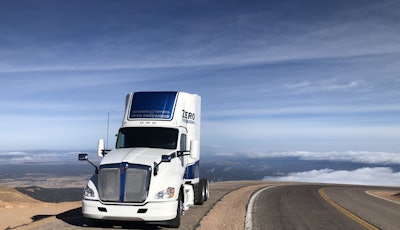 Peterbilt’s partner company, Kenworth, announced this week that its T680 fuel cell tractor also made the climb at Pikes Peak which makes perhaps for an interesting symbolic gesture regarding the increasing ascendency of alt fuel trucks and vans.
Peterbilt’s partner company, Kenworth, announced this week that its T680 fuel cell tractor also made the climb at Pikes Peak which makes perhaps for an interesting symbolic gesture regarding the increasing ascendency of alt fuel trucks and vans.Even with these encouraging developments in solid-state batteries, by no means should internal combustion be completely shelved. Now that near-zero emissions have been put to work along with hints of zero-emission internal combustion coming next, it would be completely foolish to relegate the world’s long-dependable workhorse to the crusher.
Fuel supply variances brought on by market volatility and abrupt interruptions (all-electric is especially vulnerable here through power outages), it makes good sense to maintain a fleet with a variety of powertrains. As a truck inspector in Florida showed me, diesel just isn’t the dirty malcontent it once was and will only continue to clean up its act. Consider the increasing use of B100 biodiesel which is enabled through Optimus Technologies’ Vector System. Renewable Energy Group told me this week that from a well to wheels perspective that B100 actually has less of a carbon footprint than electric. The same applies to renewable natural gas. So long story short, electric powertrains (and that includes fuel cells) are showing impressive gains while internal combustion has still got plenty of legs. Really, it’s the kind of news that should have us all dancin’ and singin’ in the rain.


